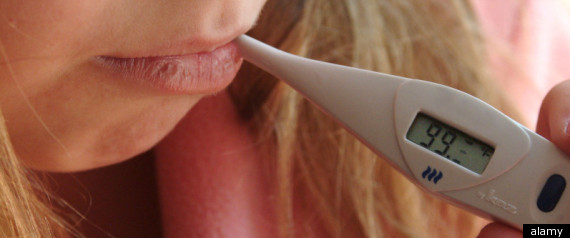Fever Increases Immune System Defense, Study Shows

The Huffington Post Amanda Chan Posted: 11/3/11 06:05 PM ET
Researchers from Roswell Park Cancer Institute found that a higher body temperature can help our immune systems to work better and harder against infected cells. The finding was published in the Journal of Leukocyte Biology.
"Having a fever might be uncomfortable, ... but this research report and several others are showing that having a fever is part of an effective immune response," John Wherry, Ph.D., deputy editor of the Journal of Leukocyte Biology, said in a statement.
Before, researchers thought that fevers worked by hindering dangerous microbes from multiplying, Wherry said.
But "this new work also suggests that the immune system might be temporarily enhanced functionally when our temperatures rise with fever," he said in the statement, though he noted that the finding should only prompt people to reconsider how they treat mild fevers, and not fevers that are dangerously high.
The secret is in a kind of immune cell, or lymphocyte, called a CD8+ cytotoxic T-cell. This kind of lymphocyte is able to destroy cells infected with viruses and even tumor cells, researchers said. Researchers found that a higher body temperature (like one achieved in a fever) raises the number of these CD8+ cytotoxic T-cells, which means a greater body response against infection.
To find this, researchers injected mice with an antigen and saw how the CD8+ cytotoxic T-cells activated to react to the antigen. Then, they raised the body temperatures of half the mice by 2 degrees centigrade, while leaving the temperatures of the other = mice alone. They found that the mice whose body temperatures were raised had more of the CD8+ cytotoxic T-cells than the mice without raised body temps.
University of Pittsburgh Medical Center clinical associate professor Dr. Amesh A. Adalja, who wasn't involved with the study, told MSNBC that the finding shouldn't mean a fever should never be treated because too-high fevers can lead to brain cell damage. Parents should still take care to lower fevers in children, particularly if the fever is above 102 degrees Fahrenheit, since high fever can lead to seizures, Adalja told MSNBC.
MSNBC reports:
Adalja also warns it"s also not worth the risk to your own health if you have heart disease, have suffered a stroke or endure other medical complications. "This is not a blanket recommendation," he says. "Secondary consequences to the fever can cause other conditions in the patient to occur or worsen. If someone has a persistent fever of 104, it's a sign of infection, and it"s not just some viral thing you are going to get over."This is certainly not the first research to suggest that fevers ramp up our body's immune responses. Discover magazine reported in 2007 on another Roswell Park Cancer Institute mouse study, which showed that mice that were heated up produced more immune cells to fight disease than mice that weren't heated.
